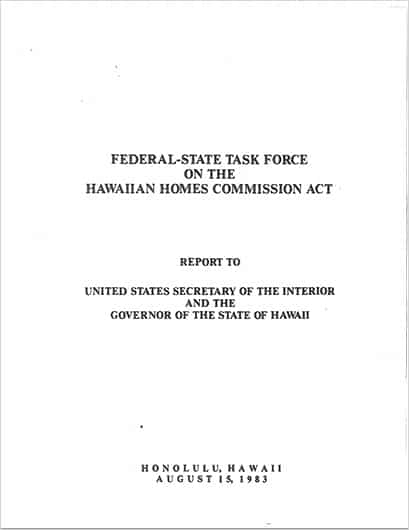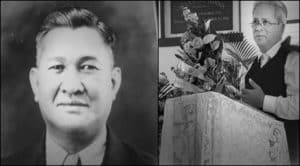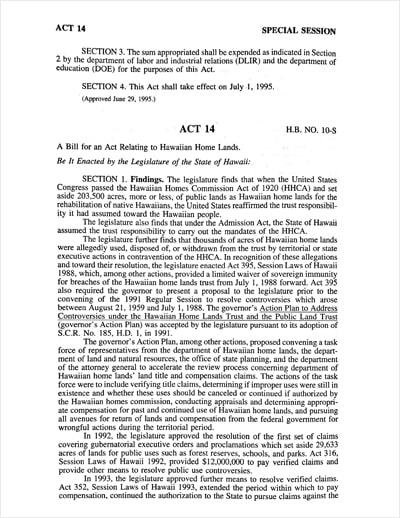Can the Executive and Legislative Branches Legitimize the Theft of DHHL Trust Lands?
At what point does the relentless thievery of Hawaiian Home Lands invalidate the very condition that allows Hawai‘i to call itself the Fiftieth State? He leo wale nō.
by Edward Halealoha Ayau
A history of stealing Hawaiian Homestead lands
In 1968, the University of Hawai‘i (UH) built the Maunakea Access Road (MAR) over lands controlled exclusively by the Hawaiian Homes Commission (HHC). UH did not seek or obtain authorization from the HHC as required by our State Constitution. And UH did not pay for the land it took.
This discredited practice was part of a tragic pattern adopted by state agencies, a practice often facilitated by governors’ executive orders that merely proclaimed, in violation of State and Federal laws, that portions of the Hawaiian Home Lands trust would be assigned for non-beneficiary use with no compensation to the trust.
A joint Federal-State Task Force in 1983, and a Governor’s Task Force in the 1990s, studied the State’s practice of taking DHHL trust lands without compensating the trust and concluded it was illegal. The studies called for the State to compensate the trust.
In 1994, the HHC approved the State’s offer for the 346.233 acres taken for highways and roads, but conditioned its approval saying, “DHHL reserves the right to hold off any release of its claims as to that particular proposal, based on any such non-compliance by the State of Hawaii.”
In 1995, the State passed Act 14, a $600 million settlement for these stolen lands, despite their assessed value of $1 billion. Ignoring the $400 million discrepancy, the State unilaterally declared this “settlement” global and final. In addition, the HHC relied on a state promise that the DHHL would receive $5 million from the sale of the Mark’s Estate to compensate for 346.233 acres of lands taken for roads and highways, including the 65.142 acres underlying the MAR.

Broken promises
From that time through today, the State has never compensated the Hawaiian Home Lands trust for any stolen roads and highways.
While the DHHL can assert that jurisdiction for the MAR was transferred to the Department of Transportation, those mere declarations cannot negate the State’s trust duties to (1) preserve the lands in the trust and (2) exercise exclusive loyalty to its beneficiaries based on State constitutional law.
These duties, incorporated in the HHCA through our State Constitution, supersede any contrary terms of Act 14. There are few legal duties higher than a trustee’s duties to its beneficiaries, and for decades the State has consistently broken that trust.
Federal laws ignored
In addition to the above violations, the State is also grossly non-compliant with federal law regarding the State’s proclaimed control of an asphalt strip laid atop land owned by the DHHL. The federal Hawaiian Homes Commission Act of 1920 (HHCA) requires that the US Department of Interior (DOI) approve all DHHL land exchanges (HHCA Sec. 206(3)). This obligation overrides any imagined State DOT ability to control a roadway illegally built over trust land.
Title 43 of the Code of Federal Regulations Part 47, lays out the proper land exchange procedures, which the state ignored.
For DHHL to have legally transferred to the DOT the land comprising the MAR, DHHL would have to answer “yes” to each of the following questions:
- Was an actual parcel of state land explicitly identified to exchange for the MAR?
- Did the HHC ever publicly take a vote to authorize its Chair to sign any disposition involving the MAR on DHHL lands or any other portion of trust lands in the vicinity of the intersection of MAR and the Daniel K. Inouye highway?
- As required by Title 43, Part 47.55
- Was a land appraisal done for the land transferred or exchanged?
- Was the appraisal reviewed by the Secretary of the Interior?
- As required by Title 43, Part 47.60
- Did the Hawaiian Homes Commission vote to enact the transfer or exchange?
- Did the HHC explicitly find that the MAR parcel was not needed for homesteading purposes?
- Were beneficiaries and homestead associations consulted about the transfer or exchange?
- Was a statement produced explaining how the transfer or exchange would advance the interests of DHHL beneficiaries?
- Was an analysis provided of the intended use of the Hawaiian Homestead lands to be conveyed?
- Were studies done of the lands to be transferred or exchanged in compliance with environmental, historic preservation, and burial laws?
- Were deeds signed by the parties?
- Was the Secretary of the Interior provided with all of the above?
- Did the Secretary of the Interior approve the deed?
In light of the above, serious questions emerge when considering the July 17, 2019, arrests of beneficiaries on the MAR. These were kūpuna exercising Hawaiian cultural practices protected by Article 12, Section 7 of the State Constitution to kia‘i (protect) sacred Maunakea. They were charged with obstruction.
In contrast, for over 50 years, UH and the DOT have benefited from using the same stolen MAR having paid nothing to the trust. Their leaders or personnel have never been arrested.
Huge implications
The faithful management of the DHHL by the State of Hawai‘i was made a condition of statehood pursuant to the State Constitution, Article 12, Section 2. Given the history of how the State has mismanaged its trust responsibilities to Hawaiian Home Lands beneficiaries, the following important questions are raised:
- Can State legislative and executive branches enact laws to legitimize the unlawful and uncompensated taking of DHHL trust lands and ignore the steps required by law to implement remedies required by the State Constitution and federal law?
- Failing to act for 24 years, should the State have arrested beneficiaries on the very trust lands it stole?
- Is it appropriate for the DHHL Chair and Hawaiian Homes Commissioners to be appointed by a governor who can later ask the chair and commissioners to act in the best interest of the governor while shirking their trust responsibilities to Hawaiian Home Lands beneficiaries?
- Is it appropriate for the same Attorney General’s office to represent the State’s best interest on one hand and the best interests of Hawaiian Home Lands beneficiaries on the other? Or is there an inherent conflict of interest present in that arrangement?
- Can the State credibly claim to have fulfilled its trust duties to Hawaiian Home Lands beneficiaries when the waitlist to receive a homestead is over 27,000, when the courts have found that the State has grossly underfunded the DHHL, and when all the while the State has stolen trust lands, and in many instances still without compensation to DHHL and its beneficiaries?
At what point does the relentless thievery of Hawaiian Home Lands invalidate the very condition that allows Hawai‘i to call itself the Fiftieth State? He leo wale nō.


